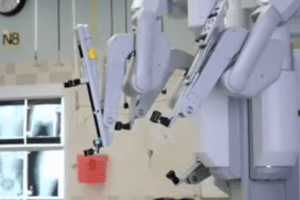
FDA this year began to investigate the device by surveying surgeons. Intuitive Surgical’s da Vinci robotic surgical system last year saw a sharp increase in the number of adverse event reports (AERs) related to it. As a consequence, the U.S. Food and Drug Administration (FDA) this year began to investigate the device by surveying surgeons about […]

FDA this year began to investigate the device by surveying surgeons. Intuitive Surgical’s da Vinci robotic surgical system last year saw a sharp increase in the number of adverse event reports (AERs) related to it. As a consequence, the U.S. Food and Drug Administration (FDA) this year began to investigate the device by surveying surgeons about their experiences performing da Vinci-assisted surgery.
Reports touched on a range of issues, including malfunctions, as well as injuries to patients, including critical injuries, according to a Medscape Medical News report.
Surgeons who used da Vinci assistance while performing surgical procedures sometimes found that the attached to the ends of the robotic arms were inadvertently responsible for puncturing bladders, and severing nerves and blood vessels.
Sometimes, the da Vinci surgical robot “seemed to have a life of its own,” Medscape Medical News reported, “inexplicably cauterizing a fallopian tube, damaging heart tissue, or refusing to let go of a patient’s tissue with its grasper.”
The number of AERs for the da Vinci Surgical System increased 34% from year to year, rising to 282 in 2012 from 211 in 2011, according to filings with the FDA’s Manufacturer and User Facility Experience (MAUDE) database, as noted by Medscape Medical News. Also during that period, the number of procedures performed using da Vinci assistance increased 26%, to 367,000 from 292,000, according to a quarterly report filed in early April by Intuitive Surgical with the U.S. Securities and Exchange Commission.
The most recent data shows that, for the first three months of 2013, MAUDE received 62 reports, placing da Vinci on track to reach 248 AERs by year end, Medscape Medical News reported.
Most AERs are filed by the manufacturer; hospitals, clinicians, and patients file some as well.
The FDA’s 10-question telephone survey began in January 2013, obtaining participation from da Vinci-using surgeons whose hospitals belong to the regulator’s so-called Medical Product Safety Network.
As for the questions, surgeons were asked about training, common repairs and patient selection. There were questions on how complications stemming from da Vinci-assisted surgeries compared with complications from conventional surgeries. Also discussed: which procedures were the most suitable for da Vinci technology, as well as which were the least suitable.
Intuitive Surgical spokesman Geoff Curtis told Medscape Medical News that the survey was part of the FDA’s routine, continuing monitoring of the products it has approved. As for the increase in AERs filed about the da Vinci, Curtis chalked up the rise to a change in the company’s reporting practices. In September 2012, he said, the company began reporting certain device malfunctions — such as breaks — that it previously had not reported.
Robotic surgery has been under investigation from various corners of late. Aside from the FDA’s investigation, beginning in March, the American Congress of Obstetricians and Gynecologists (ACOG) released a statement questioning its effectiveness. As well, health officials from some states are also shining a on robotic-assisted surgery. Massachusetts, for one, is calling for better training for doctors, as well as greater disclosure of potential risks. The New Hampshire Board of Medicine also has joined the critics.
The personal injury attorneys at Parker Waichman offer free, no-obligation case evaluations. For more information, fill out our online form or call 1-800-YOURLAWYER (1-800-968-7529).


